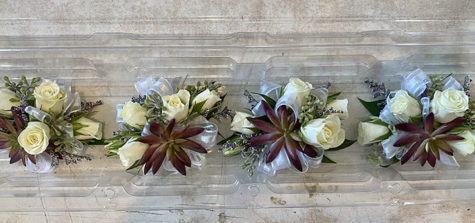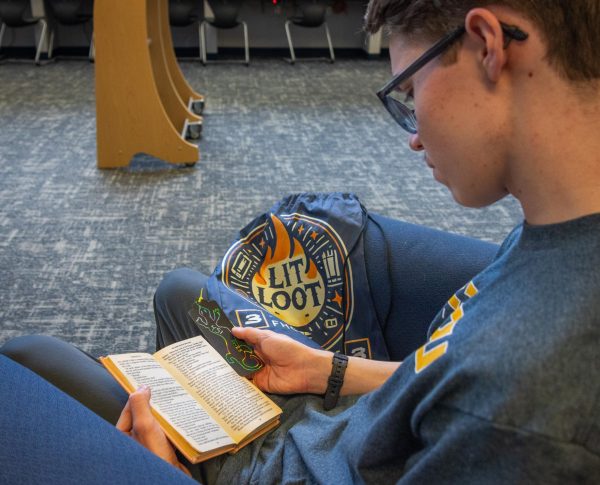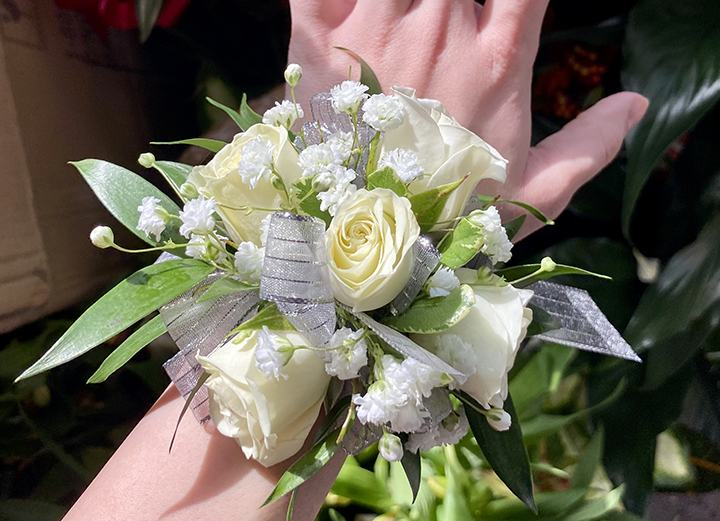Corsage History
Learn about the history behind the high school dance essential, the corsage.
Functionally Floral: Stores start to prepare for the coming dances months ahead of time, like the floral shop, The Flower Stop, Rachel works at.
Mark the date! Find a dress, find a suit, find shoes, find someone to go with, and don’t forget your corsages and boutonnieres! Every fall, high school students run down the list and check off the boxes. When it comes to flowers, many will check off the box without question, but why does this box stay on the list year after year? Why is this box a part of the list in the first place?

Before we get to the modern rendition of these miniature bouquets, we have to go back to the beginning, which is very, very far back. Over 500 years ago, the first forms of corsages were seen in ancient Greece. Originally, brides wore flowers pinned to their dresses in order to ward off bad luck and evil spirits, but also to ward off their lack of hygiene. The floral scent that wafted off of these flowers helped mask the bride’s stench. (Yuck!) Grooms started participating in this trend for similar reasons in the late 16th century. Eventually, florals became a regular part of formal attire for both men and women. It became part of the status-quo to pin flowers to your garments for funerals, balls, and other austere events, regardless of your role in the event.
From there, the tradition spread to other areas of the world, including the west. Because of the developments in hygiene, the sweet scent of the flowers was no longer needed to mask the stench of the person wearing them. So the west, in its usual fashion, capitalized on this by commercializing the custom. By the 19th century, the corsage was a staple in the world of courting. Men were expected to gift the women they were courting a corsage before heading off to any formal event, including dances. This is where these little bouquets began to more closely resemble what we know today. Because of the stingy rules of courting, the traditional placement of these flowers was adjusted. Instead of being worn in the middle of a women’s bodice, they were moved to the shoulder strap so the men could help appropriately pin them on.
As for boutonnieres, since they were also no longer needed as a form of perfume, their role in society had to change. By the end of the 19th century, boutonnieres became a symbol of luxury, elegance, and respectability. A man who wore a boutonniere and a man who was respectable became synonymous. Picking out a nice boutonniere became just as important as picking out a nice pair of shoes. Unlike corsages, the placement was never adjusted and the boutonniere stayed on the lapel of a man’s suit.
With World War II fast approaching, flowers, like many other things, had to take a back seat in America. Due to wartime shortages and increased prices, corsages halved in size. Boutonnieres also became less common during this time period. However, classy entertainers like Dean Martin, Frank Sinatra, and The Commodores kept the tradition alive. Sinatra even contributed to a new style of the boutonniere, although it wasn’t really a boutonniere in the traditional sense of the word. Sinatra’s version is actually a lapel pin that looks like a flower. After the war, the corsage and boutonniere didn’t return to their prior form or relevance. The corsage has remained small, and the boutonniere is no longer an everyday staple. Even after these bundles of blossoms exited their prime, they held on to their position as a standard part of formal events.
As fashion trends changed, floral trends changed with them. With thin dress straps becoming more and more popular, the corsage could no longer be pinned onto the shoulder of a women’s dress, so they were moved onto a wristband. This form of the corsage is what we see more often today, but the shoulder placement is still around.
Clearly, corsages and boutonnieres have withstood the test of time. Since the 16th century, they have remained relevant in some form or another. But why? There really isn’t any reason other than the fact that they’re a fun, timeless tradition! Corsages and boutonnieres have evolved with time, and they continue to do so. Almost every year, we see a new, trendy way to incorporate flowers into your formal attire. Since the 1980s, the rose and baby’s breath combination has become an iconic staple when it comes to boutonnieres and corsages. In more recent years, the flowers used in these mini bouquets have become more creative. It has become more common to see sunflowers, anemones, daisies, and other fun florals incorporated into the bouquet.
This homecoming season, when you review your annual list, consider adding an extra box for corsages and boutonnieres. Whether you’re getting one for your date, your friends, or yourself, florals will be a classy addition to your attire!
Your donation will support the student journalists of Francis Howell Central High School. Your contribution will allow us to purchase equipment and cover our annual website hosting costs. FHCToday.com and our subsequent publications are dedicated to the students by the students. We hope you consider donating to allow us to continue our mission of a connected and well-informed student body.






